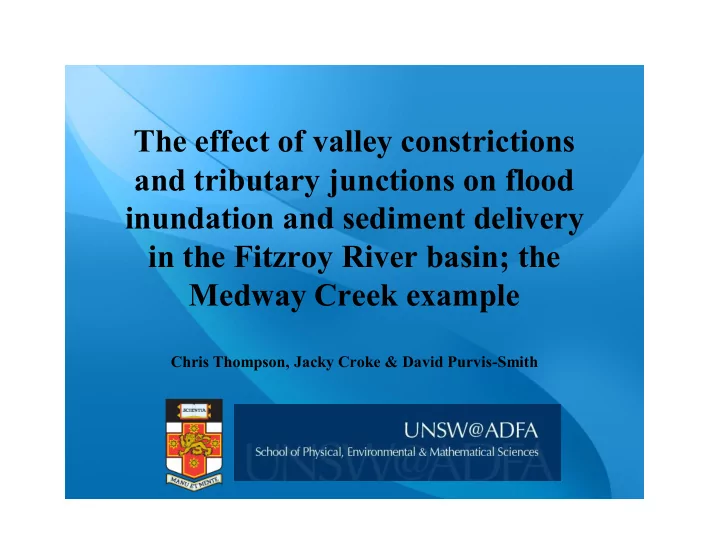

The effect of valley constrictions and tributary junctions on flood inundation and sediment delivery in the Fitzroy River basin; the Medway Creek example Chris Thompson, Jacky Croke & David Purvis-Smith
Outline • Introduction – Constrictions & Tributary junctions • Study area – Medway Catchment • Methods & Analysis – Hydrology & flood scenarios – Radionuclide Cs-137 analysis • Calibration – October 2005 event – January 2008 event
Valley Constrictions
Tributary junctions • Are the basic building blocks of river networks, • Their potential to affect channel morphology depends on relative size, • Sites of discontinuity in longitudinal sediment grain sizing, • Sites of discontinuity in smooth longitudinal river profiles, • Potential sites for increased floodplain sedimentation
Medway Catchment Study area
Medway Geology • Drummond Land type: – Dissected ranges of Permian (250-300 Ma) Colinlea Sandstone • Soils: – Dispersible sodic soils
Lower Medway Creek
Floodplain surveys
Hydrology • Analysis of flow & rainfall records 1980 (1972-85) indicate 3 flood scenarios: 1. Nogoa dominant, 2. Medway dominant, and 3. Both on 1977
Modelled scenarios Nogoa dominant For 5 year floods Medway dominant Both on
Medway Floodplain Core Cs-137 Core 9 Core 2 Vcore 3 Vcore 6 Core 11 Core 13
Oct/Nov 2005 Flood – Scenario 1
Nogoa Catchment Total Rainfall 16-20 Jan 2008 Source: DPI&E, Emerald
21 Jan Flood Jan 2008 MODIS - Peaked at Rutland homestead on 17/18 th 20 Jan 7.4m deep Landsat TM 6.5m deep 24 Jan MODIS 9.8m deep Source: ACRES, Geoscience Aust
Sedimentation
Conclusion • 3 common flood scenarios at tributary junctions in the region of high spatial and temporal rainfall variability each with different sedimentation processes at the tributary junction, • ‘Nogoa only’ floods ingress well up into the tributary with expansive deposition zone • Nogoa-Medway floods disconnect Medway sediments and prevent Nogoa sediments from ingressing into the tributary, • Role of constriction still being investigated with its influence probably taking effect further upstream due to progradation, • Jan 2008 flood was the highest on record at Rutland, however waters did not stay on the floodplain as long as previous big floods.
Acknowledgements • Marine and Tropical Research Facility (Project 3.7.2) and • Australian Research Council (DP0449886)
Recommend
More recommend